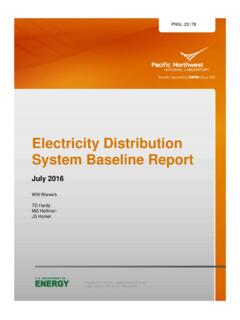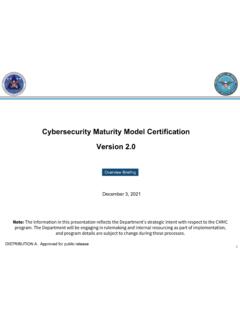Transcription of The role of community health workers in COVID-19 ...
1 The role of community health workers in COVID-19 vaccinationimplementation support guide26 April 2021 WHO and UNICEF continue to monitor the situation closely for any changes that may affect this interim guidance. Should any factors change, WHO and UNICEF will issue a further update. Otherwise, this interim guidance document will expire 2 years after the date of publication. World health Organization and the United Nations Children s Fund (UNICEF), 2021. Some rights reserved. This work is available under the CC BY-NC-SA IGO licence. WHO reference number: WHO/2019-nCoV/NDVP/CHWs_ role of community health workers in COVID-19 vaccinationimplementation support guide26 April 2021iiThe role of community health workers in COVID-19 vaccination: implementation support guideContentsAcknowledgements .. 1 Abbreviations .. 2 Executive summary .. 31. Introduction .. Background resources .. Document updates and constraints.. Target audience .. 52. Key community health worker roles in the COVID-19 vaccines rollout.
2 Planning and coordination .. Identification of target populations .. Vaccine acceptance and uptake .. community mobilization for service delivery .. Vaccine rollout tracking and follow-up .. 83. Human resources for health : optimizing roles and system support .. Policy and regulatory preparedness .. Resources and funding .. Training and supervision .. Counting and vaccinating CHWs .. Infection prevention and control .. health system strengthening .. 11 References .. 131 The role of community health workers in COVID-19 vaccination: implementation support guideAcknowledgementsLead authorsMadeleine Ballard ( community health Impact Coalition); Anne Detjen (UNICEF); Catherine Kane (World health Organization [WHO]); Maureen Momanyi (United Nations Children s Fund [UNICEF]).ContributorsThis guidance document was jointly developed by WHO, UNICEF and the community health Impact Coalition. WHO: Benedetta Allegranzi, Jhilmil Bahl, Diana Chang-Blanc, Shalini Desai, Carole Fry, Shoshanna Goldstein, Tracey Goodman, Michelle McIsaac, Lisa Menning, Teri Reynolds, Amani Siyam, Victoria : Sanghita Bhattacharyya, Julianne Birungi, Karin K llander, Jiawen Elyssa Liu, Imran Mirza, Alex Muhereza, Remy Mwamba, Rory Nefdt, Deepa Pokharel, Claudia Vivas Torrealba, Ahmadu health Impact Coalition: Rebecca Alban (VillageReach); Julia Bishop (One to One); Nandini Choudhury (Possible); Molly Christiansen (Living Goods); Kevin Fioiri (Integrate health ); Jennifer Foth (Living Goods); Ari Johnson (Muso); Stella Kanyere (Living Goods); Andrew Karlyn (Living Goods); Jordan Lerner (Dimagi); Sarah Lindsay (Living Goods); Kyle Muther (Last Mile health ); Helen Olsen (Medic Mobile); Dr Daniel Palazuelos (Partners in health ); Mallika Raghavan (Last Mile health ); Ash Rogers (Lwala community Alliance); Debbie Rogers (Praekelt); Ami Waters (Last Mile health ); Melissa West (VillageReach).
3 Carey Westgate (Living Goods). Technical expert revisionThis collaborative report is based on insights from many people:Arnhold Institute for Global health : Duncan Maru, Sheela MaruBRAC: Adam SchwartzBwindi community Hospital (Uganda): Nahabwe HavenCARE: Feven MekuriaCore Group: Nicole GrableDigital Medic: Victoria WardJohns Hopkins: Henry PerryLondon School of Hygiene & Tropical Medicine: Nikita Arora, Luisa EnriaPan American health Organization: Malhi Cho+Affiliation: Robert role of community health workers in COVID-19 vaccination: implementation support guideAbbreviationsAEFI adverse events following immunizationCHW community health workerEIR electronic immunization registriesEPI Expanded Programme on ImmunizationIFRC International Federation of Red Cross and Red Crescent SocietiesIPC infection prevention and control MSH Management Sciences for HealthNCC national coordinating committee NDVP national deployment and vaccination planPPE personal protective equipmentUNICEF United Nations Children s FundVIRAT Vaccine Readiness Assessment ToolWHO World health Organization3 The role of community health workers in COVID-19 vaccination.
4 Implementation support guideExecutive summaryThis guide is intended to support national governments in developing their national deployment and vaccination plans (NDVP) for COVID-19 vaccines by outlining the roles, needs and opportunities for community health workers (CHWs) (International Labour Organization, 2007)1 to note builds on and is structured to align with the Guidance on developing a national deployment and vaccination plan for COVID-19 vaccines (1) and the COVID-19 Vaccine Introduction Readiness Assessment Tool (VIRAT/VRAF ) (2) developed by WHO and UNICEF. This document provides human resources for health options and considerations for national governments in developing robust NDVPs for the introduction of the COVID-19 vaccine(s) that leverage community -based the world s population lacks access to essential health services (3); these and other health inequities, which in turn lead to inequities in health outcomes, is amplifying the challenge of COVID-19 vaccination.
5 Among key issues for the success globally of the vaccination effort hinges on overcoming insufficient and inequitably distributed human resources and infrastructure; inequalities in access based on gender and other social stratifiers; and mistrust in health care systems that have left too many people behind. Most CHWs are members of the communities within which they work, and are reflective of them; therefore, they are a key link between their communities and health systems. They are well positioned to help overcome access and equity barriers (4). National and subnational governments can unlock this potential by: Identifying CHW contributing roles at each stage of COVID-19 vaccines rollout. Counting and vaccinating CHWs within initial vaccine allocation as part of the essential health workforce to optimally support the COVID-19 response and continuity of essential health services. Recognizing and remunerating CHWs commensurate to tasks undertaken and training. CHWs who are linked to health systems through regular compensation, dedicated supervision and accreditation are best placed to support an effective pandemic response and to prevent the next one.
6 Considering community -based health worker representation on national coordinating committees (NCC) and subnational planning groups to contribute their community knowledge. Ensuring appropriate training (5 10) and ongoing supervision for CHWs delivering COVID-19 services, particularly for novel roles and CHWs provide health education and referrals for a wide range of services, and provide support and assistance to communities, families and individuals with preventive health measures and gaining access to appropriate curative health and social services. They create a bridge between providers of health , social and community services and communities that may have difficulty in accessing these services. Updating the International Standard Classification of Occupations (ISCO). Draft ISCO-08 Group Definitions Occupations in health . ILO; 2012 ( , accessed 6 March 2021).4 The role of community health workers in COVID-19 vaccination: implementation support guide1. IntroductionThis guide is intended to support national governments developing their national deployment and vaccination plans (NDVPs) for COVID-19 vaccines by outlining the roles, needs and opportunities for community health workers (CHWs)1 to note builds on and is structured to align with the Guidance on developing a national deployment and vaccination plan for COVID-19 vaccines (1).
7 By providing CHW-relevant considerations for the VIRAT Tool (2), this document aims to support national governments in developing robust NDVPs for introducing COVID-19 vaccine(s) that leverage all the community -based deployment, implementation and monitoring tools at their Background resourcesFor background information on COVID-19 , refer to Chapter 1 of the WHO Guidance on developing a national deployment and vaccination plan for COVID-19 vaccines (1), SAGE values framework for the allocation and prioritization of COVID-19 vaccination (11), and WHO SAGE Roadmap for prioritizing uses of COVID-19 vaccines in the context of limited supply (12).WHO, UNICEF and the International Federation of Red Cross and Red Crescent Societies (IFRC) have also published interim Guidance on community -based health care in the context of the COVID-19 pandemic (13). In addition, WHO interim guidance on health workforce policy and management in the context of the COVID-19 pandemic response (4) broadly outlines the potential roles of CHWs during COVID-19 , including delivery of essential health services.
8 As of the beginning of 2021, most vaccine candidates in clinical evaluation require two doses for optimal immunogenicity and efficacy. WHO s landscape analysis of COVID-19 vaccines in clinical development (14) is updated Document updates and constraintsThe earliest use authorization of COVID-19 vaccines was granted at the end of 2020, with additional vaccines anticipated in early 2021. Vaccines are expected to ship soon after authorization, though initial quantities will be limited (1).Given the rapid evolution of COVID-19 vaccine development, this guidance is based on information available as of March 2021 and will be updated as new information becomes available. Vaccine requirements (including cold chain and handling), funding institutions and country-level health system characteristics will have a significant impact on the most effective strategies that countries can employ to rollout COVID-19 vaccines. Where possible, relevant considerations for different potential scenarios are document was developed following a review of immunization, human resources for health , CHW and COVID-19 specific guidance and evidence, including key documents regarding COVID-19 vaccines, infection prevention and control (IPC), community engagement and health workforce.
9 An interorganizational group composed of WHO and UNICEF focal points and civil society experts in 1 As defined by ILO International Standard Classification of Occupations (ISCO), CHWs are a distinct occupational group (ISCO 3253).5 The role of community health workers in COVID-19 vaccination: implementation support guidecommunity health provided expert opinion where explicit guidance either lacks granularity or is linked to evolving knowledge of this novel global deployment of the largest ever immunization document will be added to the WHO Country Readiness and Deployment portal (15), which houses guidance, tools and training to support COVID-19 vaccines deployment. The portal includes a COVID-19 Vaccine Introduction and Deployment Costing Tool (16).In this document we share potential roles of CHWs during the rollout of COVID-19 vaccines. Alongside the overall package of training and capacity materials provided by the Country Readiness and Delivery team, this note provides options for countries to incorporate and leverage community -based resources in their NDVPs.
10 Target audienceThis document is intended to be used by ministries of health , with support from WHO and UNICEF country offices. 6 The role of community health workers in COVID-19 vaccination: implementation support guide2. Key community health worker roles in the COVID-19 vaccines rolloutCommunity-based health workers routinely play critical roles in new vaccine introduction, including in planning, identification of target groups, community engagement and mobilization, service delivery, and in tracking and follow-up. Alongside other community -based providers, CHWs are key interlocutors, with their knowledge of last mile health service delivery, experience supporting vaccine acceptance and uptake, and shared lived experience that fosters trust and credibility within communities. Clearly defining and costing the inputs of CHWs within the NDVP will assist governments and implementation planners at all levels in addressing the scale, speed, and complexity involved in COVID-19 vaccine (Policy and regulatory preparedness) includes critical considerations for situations in which national governments decide to consider the implications of providing temporary clearance for CHWs to administer a specific COVID-19 vaccine.















